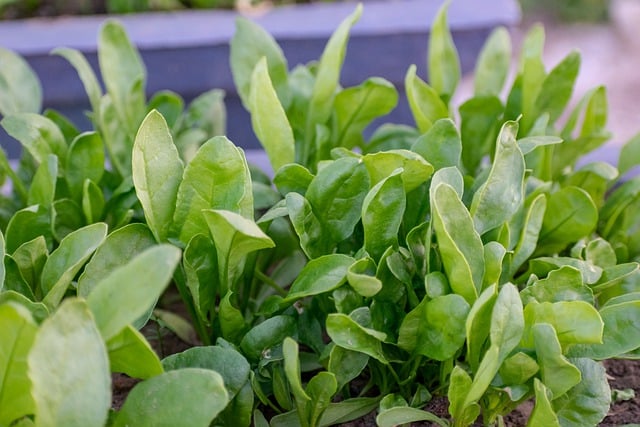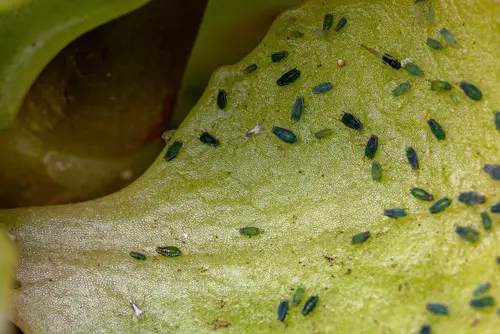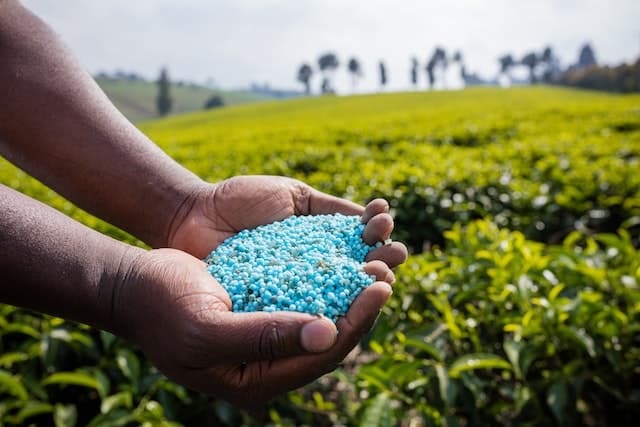Spinach is a healthy and nutritious vegetable that is often used in salads, smoothies, and other dishes. However, sometimes white spots can appear on the leaves of spinach, causing concern for those who consume it.
White spots on spinach leaves can be caused by a variety of factors, including weather conditions, pests, and diseases. It is important to understand the causes of white spots on spinach leaves, as well as how to prevent and treat them, in order to maintain healthy plants and safe consumption.
One of the most common causes of white spots on spinach leaves is cold and moist weather conditions. These conditions can create a favorable environment for parasites and other organisms that reproduce quickly and cause damage to the plant.
Other causes of white spots may include over-irrigation, replanting, and exposure to certain pests and diseases. Identifying the specific cause of the white spots is important in order to determine the best course of action to prevent and treat them.
Understanding the causes of white spots on spinach leaves is just the first step in maintaining healthy plants and safe consumption. It is also important to know how to prevent and treat white spots, as well as how they can impact the growth and health of spinach plants.
By taking the necessary steps to prevent and treat white spots, gardeners and consumers can enjoy healthy and nutritious spinach plants for years to come.
Key Takeaways on White Spots on Spinach Leaves
- Understanding the causes of white spots on spinach leaves is important for maintaining healthy plants and safe consumption.
- Identifying specific pests and diseases that cause white spots is crucial in determining the best course of action to prevent and treat them.
- By taking preventative measures and treating white spots promptly, gardeners and consumers can enjoy healthy and nutritious spinach plants.
More posts on this category:
Understanding White Spots on Spinach Leaves

Spinach is a nutritious plant that is widely consumed around the world. However, sometimes spinach leaves develop white spots that can cause concern for consumers. In this section, we will explore what causes white spots on spinach leaves and whether it is safe to eat spinach with white spots.
White spots on spinach leaves can be caused by various factors, including fungal diseases, pests, and natural plant structures. One common fungal disease that causes white spots on spinach leaves is white rust.
White rust appears as small, white blisters on the underside of the leaves that can grow and consume the entire leaf as the disease progresses. Another fungal disease that causes white spots on spinach leaves is downy mildew, which also causes chlorotic spots on the upper side of the leaves.
In addition to fungal diseases, pests like spider mites and thrips can also cause white spots on spinach leaves. These pests feed on the leaves, leaving behind small white spots that can become more prominent as the damage accumulates. However, it is worth noting that not all white spots on spinach leaves are harmful.
In fact, spinach leaves naturally have tiny hair-like structures called trichomes that can sometimes appear as white spots or fuzz on young spinach plant leaves. These trichomes are a part of the leaf and can be seen in many plant leaves, including spinach.
So, is it safe to eat spinach with white spots? It depends on the cause of the white spots. If the white spots are caused by natural trichomes or harmless pests, then the spinach is safe to eat.
However, if the white spots are caused by fungal diseases like white rust or downy mildew, then it is best to avoid eating the affected leaves. These diseases can affect the taste and texture of the spinach and can also be harmful to human health.
White Spots on Spinach Leaves – 3 Common Problems
Spinach is a nutritious and delicious leafy vegetable that can be consumed raw or cooked. However, sometimes spinach leaves develop white spots, which can be concerning to some people. There are several reasons why white spots may appear on spinach leaves, including fungal diseases, pest infestations, and environmental factors.
1. Fungal Diseases
Fungal diseases are one of the most common causes of white spots on spinach leaves. White rust is a fungal disease that can cause white spots on the leaves of spinach plants.
This disease thrives in cool and moist conditions and can spread rapidly if not treated promptly. Other fungal diseases that can cause white spots on spinach leaves include downy mildew and powdery mildew.
2. Pest Infestations

Pest infestations can also cause white spots on spinach leaves. Aphids and flea beetles are common pests that can cause white spots on spinach leaves. These pests feed on the leaves of spinach plants and can cause damage that appears as white spots. In addition, whiteflies and spider mites can also cause white spots on spinach leaves.
3. Environmental Factors
Environmental factors such as hail damage, chemical burn, and over-irrigation can also cause white spots on spinach leaves. Hail damage can cause physical damage to the leaves, resulting in white spots.
Chemical burn can occur if spinach plants are exposed to chemicals such as herbicides or pesticides. Over-irrigation can cause the soil to become waterlogged, which can lead to fungal diseases and white spots on the leaves.
Identifying Specific Diseases and Pests
Spinach is a nutritious and delicious leafy green that is loved by many. However, it is susceptible to various diseases and pests that can cause white spots on its leaves. Here are some of the most common diseases and pests that cause white spots on spinach leaves:
1, White Rust
White rust is a fungal disease that affects spinach leaves. It causes white or yellow spots on the upper surface of the leaves and a whitish or grayish growth on the underside of the leaves.
The disease can cause the leaves to curl and distort, and it can eventually lead to the death of the plant. White rust is most common in cool, wet weather conditions.
2. Downy Mildew
Downy mildew is a fungal disease that causes white or grayish spots on the upper surface of the leaves and a downy growth on the underside of the leaves. The disease can cause the leaves to yellow and eventually die. Downy mildew is most common in warm, humid weather conditions.
3. Anthracnose
Anthracnose is a fungal disease that causes white or grayish spots on the leaves, stems, and fruits of spinach plants. The spots can be circular or irregular in shape, and they may have a dark border. The disease can cause the leaves to wilt and die. Anthracnose is most common in warm, humid weather conditions.
4. Cercospora

Cercospora is a fungal disease that causes white or grayish spots on the leaves of spinach plants. The spots can be circular or irregular in shape, and they may have a dark border. The disease can cause the leaves to yellow and eventually die. Cercospora is most common in warm, humid weather conditions.
5. Leaf Miner
Leaf miner is a pest that causes white or yellowish spots on the leaves of spinach plants. The pest lays its eggs on the leaves, and the larvae burrow into the leaves and create tunnels. The tunnels can cause white or yellowish spots on the leaves, and they can eventually cause the leaves to die. Leaf miner is most common in warm, dry weather conditions.
6. Flea Beetle
Flea beetle is a pest that causes white or yellowish spots on the leaves of spinach plants. The pest feeds on the leaves, and it can cause small holes and white or yellowish spots on the leaves. Flea beetle is most common in warm, dry weather conditions.
Effect on Spinach Leaves
White spots on spinach leaves can be an indication of various diseases, pests, or environmental factors. These spots can range from small flecks to large blotches, and they may be located on the upper or lower surface of the leaf.
One common cause of white spots on spinach leaves is fungal infections. Fungi can infect the leaves and cause necrotic lesions that appear as white or gray spots. These lesions can spread and cause the leaf to wither and die. Fungal infections can be prevented by keeping the plants dry and providing good air circulation.
Another cause of white spots on spinach leaves is bacterial infections. Bacteria can cause leaf spots that are usually small and circular. These spots may be surrounded by a yellow halo and can merge together to form larger areas of discoloration. Bacterial infections can be prevented by practicing good hygiene and avoiding overhead watering.
In addition to diseases, white spots on spinach leaves can also be caused by pests. For example, spider mites can cause stippling on the leaves, which appears as small white dots. These dots can merge together to form larger areas of discoloration. Spider mites can be controlled by using insecticidal soap or neem oil.
Environmental factors can also cause white spots on spinach leaves. For example, exposure to extreme temperatures, low humidity, or high light levels can cause the epidermis of the leaf to break down and form white spots. To prevent this, spinach plants should be grown in a location with consistent temperatures and humidity levels.
Impact on Human Consumption
White spots on spinach leaves may raise concerns about the safety of consuming the vegetable. However, in most cases, these spots are harmless and do not pose a risk to human health.
The white spots on spinach leaves are likely trichomes, which are small hair-like structures that help the plant to retain moisture. These spots are more common on younger leaves and are not harmful to human consumption.
It is important to note that not all white spots on spinach leaves are trichomes. In some cases, the spots may be caused by fungal or bacterial diseases. These spots may not be safe to eat and may indicate that the plant has been infected with a pathogen.
If the white spots on spinach leaves are caused by insects such as whiteflies or scale insects, they can be removed by washing the leaves thoroughly before consumption. According to an AVA spokesperson, these insects are not harmful to human health if removed from the vegetable.
Preventing and Treating White Spots

Spinach plants are susceptible to white rust, a fungal disease that causes white spots on the leaves. Fortunately, there are several ways to prevent and treat this disease. In this section, we will discuss the most effective methods for preventing and treating white spots on spinach leaves.
Using Fungicides
Systemic fungicides can be applied to spinach plants at the time of planting new seedlings to prevent white rust. It is important to read the product labels to ensure that the fungicide is safe for use on edibles and intended for spinach white rust.
One example of a fungicide that can be used is chlorothalonil, which is effective against a wide range of fungal diseases.
Applying Pesticides
Pesticides can also be used to prevent and treat white spots on spinach leaves. Neem oil is a natural pesticide that is effective against a variety of pests, including white rust. It works by disrupting the insect’s hormonal balance, making it difficult for it to reproduce. Another option is to use a floating row cover to protect the plants from pests.
Implementing Gardening Techniques
Gardening techniques can also be used to prevent and treat white spots on spinach leaves. Crop rotation is an effective method of control of leaf spot in cruciferous vegetables and most other cruciferous plant diseases.
Watering beneath the plants instead of overhead can discourage white spot on leafy vegetables. Clearing the ground around your garden plot of weeds that may carry the pathogens is also important.
Maintaining Healthy Spinach Varieties
Choosing Resistant Varieties
One of the best ways to maintain healthy spinach varieties is to choose resistant varieties. Spinach varieties that are resistant to common diseases and pests can help reduce the risk of white spots on spinach leaves.
For example, some varieties of spinach, such as ‘Tyee’ and ‘Bloomsdale Long Standing’, are resistant to downy mildew, which is a common disease that can cause white spots on spinach leaves.
When selecting a spinach variety, it is important to choose one that is well-suited for the local climate and growing conditions. Spinach varieties that are adapted to the local climate are more likely to thrive and produce healthy leaves.
Proper Fertilization

Proper fertilization is also important for maintaining healthy spinach varieties. Spinach is a heavy feeder and requires regular fertilization to produce healthy leaves. A balanced fertilizer, such as a 10-10-10 or 20-20-20 blend, can provide the necessary nutrients for healthy growth.
It is important to avoid over-fertilization, as this can lead to excessive growth and weakened plants that are more susceptible to disease and pests. A soil test can help determine the appropriate amount of fertilizer for the specific growing conditions.
Weed Control
Weed control is essential for maintaining healthy spinach varieties. Weeds can harbor pests and diseases that can spread to the spinach plants, leading to white spots on the leaves. Regular weeding and mulching can help prevent weeds from taking hold in the garden.
It is also important to avoid using herbicides near spinach plants, as these can damage the leaves and weaken the plants. Hand weeding and hoeing are effective methods of weed control that are safe for spinach plants.
Frequently Asked Questions
Are white spots on spinach leaves harmful?
White spots on spinach leaves are generally not harmful. However, it is important to identify the cause of the white spots to ensure that they are not a symptom of a more severe issue.
How do I prevent white spots from forming on my spinach leaves?
To prevent white spots from forming on spinach leaves, ensure that the plants are watered regularly and receive adequate sunlight. Additionally, it is important to avoid overcrowding the plants and to maintain proper spacing.
What causes white spots on spinach leaves?
White spots on spinach leaves can be caused by a variety of factors, including fungal infections, insect infestations, and nutrient deficiencies. Identifying the cause of the white spots is essential to determine the appropriate treatment.
Can spinach with white spots still be eaten?
Spinach with white spots can still be eaten, as long as the spots are not caused by a severe issue such as a fungal infection. It is important to thoroughly wash the spinach leaves before consumption.
Is it safe to eat spinach with discoloration on the leaves?
Spinach with discoloration on the leaves can still be eaten, as long as the discoloration is not caused by a severe issue such as a fungal infection. It is important to thoroughly wash the spinach leaves before consumption.
How can I treat white spots on my spinach leaves?
The treatment for white spots on spinach leaves depends on the cause of the spots. For fungal infections, fungicides can be used. For insect infestations, insecticides can be used. For nutrient deficiencies, it is important to ensure that the plants receive adequate nutrients.

Hey, I’m Lisa and I’ve been an avid gardener for over 30 years. I love writing, talking and living in the garden! Feel free to connect with me on my socials below


